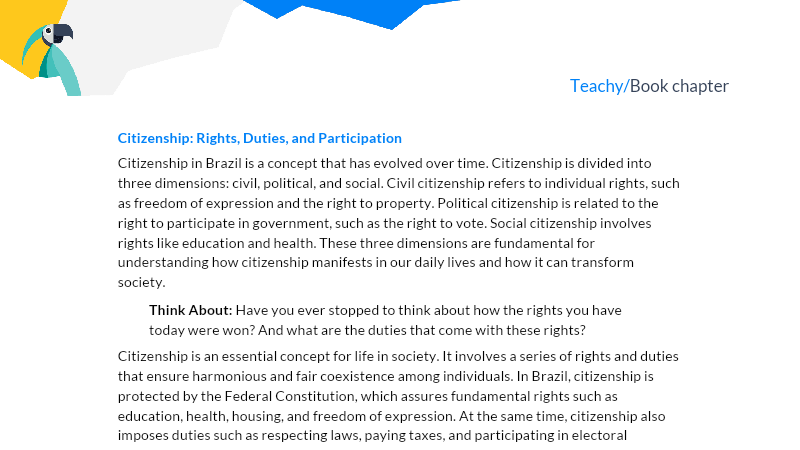Introduction
Relevance of the theme
Ahoy, young explorers! Are you ready to embark on an incredible journey through the world of Cultural Diversity and Territory? This theme is like a hidden treasure that helps us discover and value the different ways in which people live, celebrate, and see the world around them. Each place on our planet has its own history, traditions, foods, clothes, music, and games that make that location unique and special. By learning about cultural diversity, you will become great geography detectives, capable of better understanding how diverse cultures contribute to and enrich not only the place where we live but also our great Brazil and the whole world!
Contextualization
Like a colorful mosaic, the theme of Cultural Diversity and Territory fits perfectly into the big picture of Geography. This study allows us to see planet Earth as an art gallery full of wonderful and different cultures. Here, in our current module, we will learn about how people and places are interconnected, and how cultures blend and change over time, creating new patterns in this mosaic. Have you ever thought about how our Brazilian culture is a mixture of many others? That's what we are going to explore, understanding how each culture has something special to share and teach. This is part of what you call 'curriculum', which is like a map that guides our learning in Geography and other subjects.
Theory
Examples and cases
Imagine a party where each person brings a typical dish from their family. Someone brought shrimp bobó, another prepared sushi, and there's even someone who brought apple strudel. This mix of flavors shows how each culture has its culinary traditions, which are just a piece of the rich cultural diversity of our world. Now, think of a map full of pictures of people in different clothes, music of various rhythms, and games from different parts of the world. These are living examples of how cultural diversity is present in our daily lives and how it is important for us to understand who we are and how we interact with the environment and other people around us.
Components
What is Culture?
Culture is like a treasure chest that holds everything people in a place have created, learned, and shared among themselves, such as the language they speak, the celebrations they commemorate, the music they listen to, and even children's games. Each culture is unique and, together, they form a colorful mosaic that covers the world we live in. Discovering more about different cultures is like opening this treasure chest and marveling at what each one has to offer.
Cultural Diversity
Cultural diversity is like a garden full of flowers of all types and colors. This garden represents how people, even though so different, can live together and share their traditions, foods, music, and stories. This teaches us to respect and learn from differences. Cultural diversity also helps make our lives more interesting because there is always something new to discover and learn from others.
Territory and Culture
Territory is like the ground where the garden of diversity is planted. It is made up of places where people live, work, and have fun, and each little piece has its own culture. Just as we take care of the garden so that all the flowers can grow healthy, we must know and value the different territories and cultures so that everyone can coexist well. When we talk about territory, we talk about mountains, rivers, cities, and fields, but also about the people and everything they bring in cultural terms.
Deepening the theme
Now that we understand what culture is, let's dig deeper! Each place on our planet has its own way of doing things, speaking, dressing, and even playing. These differences come from many years ago, from the stories of many people's grandparents' grandparents, and change a little bit every day, with each new idea someone has. It's as if each culture were a book full of pages, and each person living in it is like a writer who can add a new story or a new word to that book. And, just like in a library, the more books from different cultures we read, the more we learn and the more stories we have to tell.
Key terms
Culture: Set of customs, traditions, beliefs, and art that defines a group of people. Cultural Diversity: Variety of cultures and differences present in a society or among societies. Territory: It is a defined space occupied by a group of people who share the same culture.
Practice
Reflection on the theme
Let's think together: how would the world be if we were all the same, liked the same things, and lived in the same way? Wouldn't we miss out on many incredible discoveries and inventions that came from different cultures? And how do you think it would be if we mixed all types of dance and music that exist in the world at a big party? Reflecting on these questions helps us see how each culture is a colorful thread that weaves the great tapestry of the world we live in.
Introductory exercises
Draw a map of your neighborhood and mark the places where cultural events and festivals take place. What types of culture do you find in these events?
Choose a dance or music from a different place in the world and try to learn a little about it. What can this dance or music tell us about the people who live there?
Make a list of typical dishes from different cultures that you have already tried or would like to try. What do these foods reveal about the places they come from?
Projects and Research
Cultural Research Project: Choose a country you are curious to know about and do a small research. Find out about the typical food, traditional festivals, usual clothing, and games that children play. Create a mural with images and information to share with the class what you discovered about the cultural diversity of that country.
Expanding
What if we went further? Did you know that the languages people speak are also part of the culture? In Brazil, besides Portuguese, there are many other languages, such as indigenous languages and those of immigrants. And you know what's even cooler? Some words we use in our daily lives came from other languages! We can learn a lot by exploring the languages and dialects that exist in Brazil and around the world. How about starting to discover some of these words and what they mean?
Conclusion
Conclusions
Throughout this chapter, we embarked on a fascinating expedition through the world of cultural diversity and how it intertwines with territory. We discovered that culture is a treasure that each group of people, in every corner of the planet, shares and celebrates in unique ways, shaping how they live, express themselves, and interact with the environment. Understanding cultural diversity means understanding that each person carries with them a particular universe of traditions and customs, which together form the rich mosaic of humanity. The different ways of cooking, dressing, dancing, and speaking are fragments of this mosaic that enrich places and contribute to the identity of each territory.
We learned that valuing and respecting diversity is essential to living in harmony because, just like the various flowers in a garden, cultural variety makes our lives more colorful and interesting. By exploring cultures, we grow in empathy and knowledge, becoming more open to learning and celebrating what each culture has to offer. This openness is the key to building a fair and inclusive society, where everyone has the opportunity to contribute and be valued for their differences.
Finally, we reflected on how culture is constantly evolving and interacting, influenced by individuals and territory. The proposed activities, such as creating murals and researching languages, encourage further exploration of this vital theme. Looking at our surroundings and at Brazil, we realize that we are part of a vibrant and diversified culture, which is the result of the contribution of many other cultures throughout history. Therefore, by selecting and valuing elements from different cultures, we not only enrich our understanding of local, regional, and Brazilian culture but also actively participate in the celebration and preservation of the cultural heritage we share.



